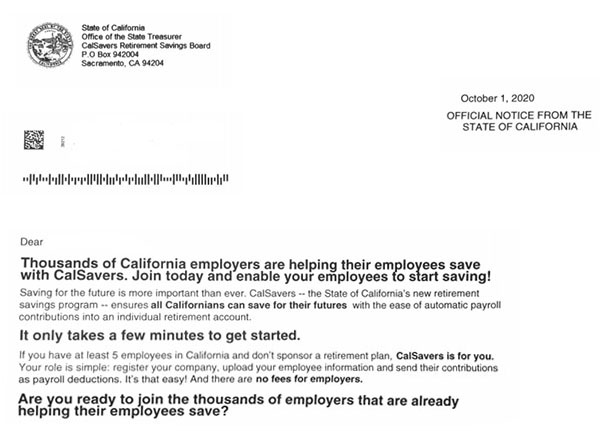What You Need to Know About CalSavers
California’s Mandatory Retirement Savings Plan
Updated March 13, 2023

A substantial amount of American households have no retirement savings, and California implemented its own solution.
Here’s everything you need to know about the CalSavers mandatory retirement savings plan for businesses with 5 or more employees.
This law affects about 5-7 million Californians who work for an employer without a pension or 401(k) account.
California Calsavers Mandatory Retirement Plan
It’s called SB-1234 (easy to remember) and you can read the full text of the Bill here.
The CalSavers program is a state-managed Individual Retirement Account (IRA).
The savings program has professionally managed investments with oversight from a public board of directors.
What EMPLOYERS Need To Know
Effective June 30, 2022, all employers with 5 or more employees, who didn’t already offer a qualified retirement plan, must have enrolled in CalSavers.
State law requires employers that don’t offer their own retirement plan to facilitate CalSavers. If you employed an average of at least five California-based employees in the previous calendar year (at least one of whom is age eighteen) and don’t sponsor a qualified retirement plan, your business is required to register for CalSavers.
CalSavers FAQs
Qualified retirement plans include:
- 401(a) – Qualified Plan (including profit-sharing plans and defined benefit plans)
- 401(k) plans (including multiple employer plans or pooled employer plans)
- 403(a) – Qualified Annuity Plan or 403(b) Tax-Sheltered Annuity Plan
- 408(k) – Simplified Employee Pension (SEP) plans
- 408(p) – Savings Incentive Match Plan for Employees of Small Employers (SIMPLE) IRA Plan
- Payroll deduction IRAs with automatic enrollment
“Due to a recent change in State law, employers with fewer than 5 employees are no longer exempt from the mandate.”
Per Senate Bill 1126, which went into effect January 1, 2023, employers with one or more employees are eligible for CalSavers. Employers with an average of 1—4 employees in the previous calendar year will be required to register by December 31, 2025, if they do not offer a qualified retirement plan.”
CalSavers Outreach Team
If the employer uses a payroll service such as ours, they need to make sure they have all of the information they need to start withholding from employees IF the employees do not opt out.
What EMPLOYEES Need To Know
CalSavers provides a low-cost portable retirement savings plan through your workplace.
If your employer has at least five employees and doesn’t offer a qualified retirement plan, you are eligible to enroll in the program.
The program is voluntary. Employees will have the option to enroll once a year during open enrollment – and they will also have the option to opt out.
All employees of a participating employer are eligible as long as they are at least age eighteen and have the status of an employee under California law. There are no minimum requirements based on hours worked or tenure with their employer.
Employees are eligible to participate in CalSavers from the first day they are hired. Participating Employers are required to upload them to the portal within 30 days of their hire date.
If workers elect to participate in the program, they would automatically have a small percentage of their pay deposited into their CalSavers account.
The cost to employees comes out to about $0.83 – $0.95 per year for every $100 in the employee’s account (depending on the investment selection). This covers the costs of administering the program and fund expenses. The fee is automatically taken out of the account balance.
From the Calsavers website:
“The State of California created CalSavers to ensure that all Californians have access to a workplace retirement savings program by providing a simple, portable, low-cost way for workers to invest in their futures.“

- You contribute to a Roth Individual Retirement Account (IRA) that belongs to you.
- Your participation is completely voluntary: you can opt out or back in at any time.
- You can stick with the standard options for savings rates and investments, or you can choose your own.
- You keep your account even if you change jobs.
- Your savings rate will automatically increase by 1% each year until your savings rate reaches 8%, unless you choose otherwise.
For The Self-Employed
From the CalSavers site on Self-Enrollment:
1. What do I need to enroll?
To enroll as an individual (not through an employer), you must:
- have earned income.
- be at least age eighteen.
- have a bank account from which you will make contributions, and
- provide some personal information, including full legal name; Social Security number or Individual Taxpayer Identification Number; date of birth; physical U.S. street address; designated email address; and any other information reasonably required by the Program for purposes of administering the Program.
- either make an initial contribution of at least $10 from your bank account or establish a recurring contribution or payroll direct deposit for a minimum of $10 per quarter.
You can join the program today on the Saver website.
Before your CalSavers account is established, you will be asked to acknowledge that:
- you understand the eligibility requirements for the Roth IRA contribution you are making, and you qualify to make the contribution;
- you have received a copy of the Program Disclosure Booklet, the Custodial Account Agreement, Disclosure Statement, and Financial Disclosure;
- you understand that the terms and conditions that apply to a Roth IRA are contained in the Custodial Account Agreement and you agree to be bound by those terms and conditions; and
- you understand that you may revoke your Roth IRA without penalty within seven days from the date you receive the Disclosure Statement by mailing or delivering a written notice to the Program administrator.
Bottom Line
If an employer does not offer a qualified retirement plan, they are mandated to enroll in the CalSavers plan to allow their employees to save for retirement.
An employer may offer a retirement plan, but it does not mean it is a “qualified retirement plan” so employers need to verify they are in compliance.
All qualified retirement plans are visible in the “Getting Started” tab of the Employers drop-down menu on the CalSavers website.
CalSavers also provides an email template that Employers can use to send to their employees (under the “Help Center” section). Once a business is registered for CalSavers, the employer can review “How do I communicate to our employees about CalSavers?” section.
Get started here:
CalSaversAt Pacific Payroll Group, we already have all of the necessary information (for our clients) once the Employers register on CalSavers AND select Pacific Payroll as their payroll provider. You can search for “Pacific Payroll” during registration.
Pacific Payroll will then upload employee data and submit payroll contributions on behalf of employees. If employers meet the requirements to be exempt from CalSavers they will need to declare this to the State via the CalSavers website.
When employee data is uploaded to the CalSavers website, the State will notify each employee directly (within approximately 30 days) and it is at this time the employee can opt out, select a contribution amount, or automatically be enrolled with 5% of their pay withheld and paid into CalSavers.
Contact Pacific Payroll Group via email or by calling 949.215.3769 with any questions.
As a final reminder, employers are not allowed to offer advice on what employees should choose.
If our clients / business owners have questions on CalSavers, we recommend speaking with your CPA, HR department, or CalSavers directly.
If you have questions on payroll deductions or setup, please let us know. We will always work quickly to answer directly or provide you with a name of someone who can.
We’re always here for you.

